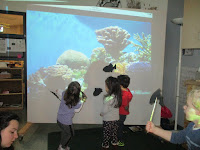Week in Review: January 25th- 29th
Creating, Sending and Receiving Messages
As a class, we extended our thinking about how people help one another within our community. At group time, we talked about how mail carriers help deliver letters and packages to people across the country. We went on to discuss how mail carriers know who to send the letters to. During explorations, we provoked the children's thinking with mailboxes, mail carrier outfits, white paper and envelopes. The children took turns writing and receiving letters. They enjoyed pretending to be the mail carrier by removing the mail from the mailboxes, and delivering it to correct person. In the coming weeks, we will be discussing how the mail gets sorted, and the different ways the mail can be delivered.
Early Childhood Standards of Quality Met:
- Participation-Cooperation-PlayNetworking-Contribution. Demonstrate increasing ability to be together with others, in play or intellectual learning opportunities and/or making positive efforts for the good of all; join a community of learners in person and digitally as appropriate.
- Writing Skills. Children begin to develop writing skills to communicate and express themselves effectively for a variety of purposes.
- Positive Attitudes about Literacy. Children develop positive attitudes about themselves as literate beings — as readers, writers, speakers, viewers, and listeners.
- Diversity of Communication. Children begin to understand that communication is diverse and that people communicate in a variety of ways.
Testing Force
 The children have been interested in how objects can move with direct and in-direct force. We explored how our cars travel down the slide. The children developed several different strategies for manipulating their cars on the slide. Many of the children would release their car at top of the ramp and watch as it traveled down. They relied on the gravitational force to move their car down the ramp. While others explored how they could push their car down the ramp. The children who used this strategy, noticed that their car would either make a sharp turn to the right or the left, or it would reach the bottom of the slide faster.
The children have been interested in how objects can move with direct and in-direct force. We explored how our cars travel down the slide. The children developed several different strategies for manipulating their cars on the slide. Many of the children would release their car at top of the ramp and watch as it traveled down. They relied on the gravitational force to move their car down the ramp. While others explored how they could push their car down the ramp. The children who used this strategy, noticed that their car would either make a sharp turn to the right or the left, or it would reach the bottom of the slide faster.
Later in the week, we explored how we can move objects through a path using a tool. We provided the children with halved cardboard tubes, pom poms, and a baster. The children explored squeezing the baster to move the pom-poms through the cardboard tubes. The children develop various strategies for manipulating the basters to get the best results. A few children were able to hold the shaft of the baster and squeeze the bulb, which resulted in their pom-pom traveling farther down the path.
Early Childhood Standards of Quality Met:
- Initiative-Engagement-Persistence Attentiveness. Children demonstrate the quality of showing interest in learning; pursue learning independently.
- Reasoning-Problem Solving-Reflection. Children demonstrate a growing capacity to make meaning, using one’s habits of mind to find a solution or figure something out.
- Observation and Inquiry. Children develop positive attitudes and gain knowledge about science through observation and active play.
- Curiosity–Inquiry-Questioning Tinkering-Risk Taking. Children demonstrate an interest and eagerness in seeking information (e.g., be able to see things from a different perspective, fiddling with something to figure it out or attempting a reasonable solution).
Experimenting with Aquatic Animal Cut-Outs
Last week, we explored the various animal cut-outs in front of a light source. We wanted to extend the children's thinking about animals by projecting a habitat on the big screen. We gave the children aquatic animal cut outs and observed their interactions with the projected image. Many of the children explored how they could portray their fish swimming.
Early Childhood Standards of Quality Met:
- Living and Non-living Things. Children show a beginning awareness of scientific knowledge related to living and non-living things.
- Knowledge about the Earth. Children show a beginning awareness of scientific knowledge related to the earth.
- Curiosity–Inquiry-Questioning Tinkering-Risk Taking. Children demonstrate an interest and eagerness in seeking information (e.g., be able to see things from a different perspective, fiddling with something to figure it out or attempting a reasonable solution).
Acting Out "The Little Red Hen"
As a class, we read the "Little Red Hen." Then we discussed the beginning, middle and end of the story. During explorations, the children were given masks to re-enact the story. Ms. Nivine read the story aloud, while the children brought the characters to life. The children enjoyed pretending to "thrashing the wheat" and "baking the bread."
Early Childhood Standards of Quality Met:
- Spoken Language: Expressive. Children develop abilities to express themselves clearly and communicate ideas to others.
- Spoken Language: Receptive. Children grow in their capacity to use effective listening skills and understand what is said to them.
- Dramatic Play. Children show how they feel, what they think, and what they are learning through dramatic play.
- Participation-Cooperation-PlayNetworking-Contribution. Demonstrate increasing ability to be together with others, in play or intellectual learning opportunities and/or making positive efforts for the good of all; join a community of learners in person and digitally as appropriate.









No comments:
Post a Comment